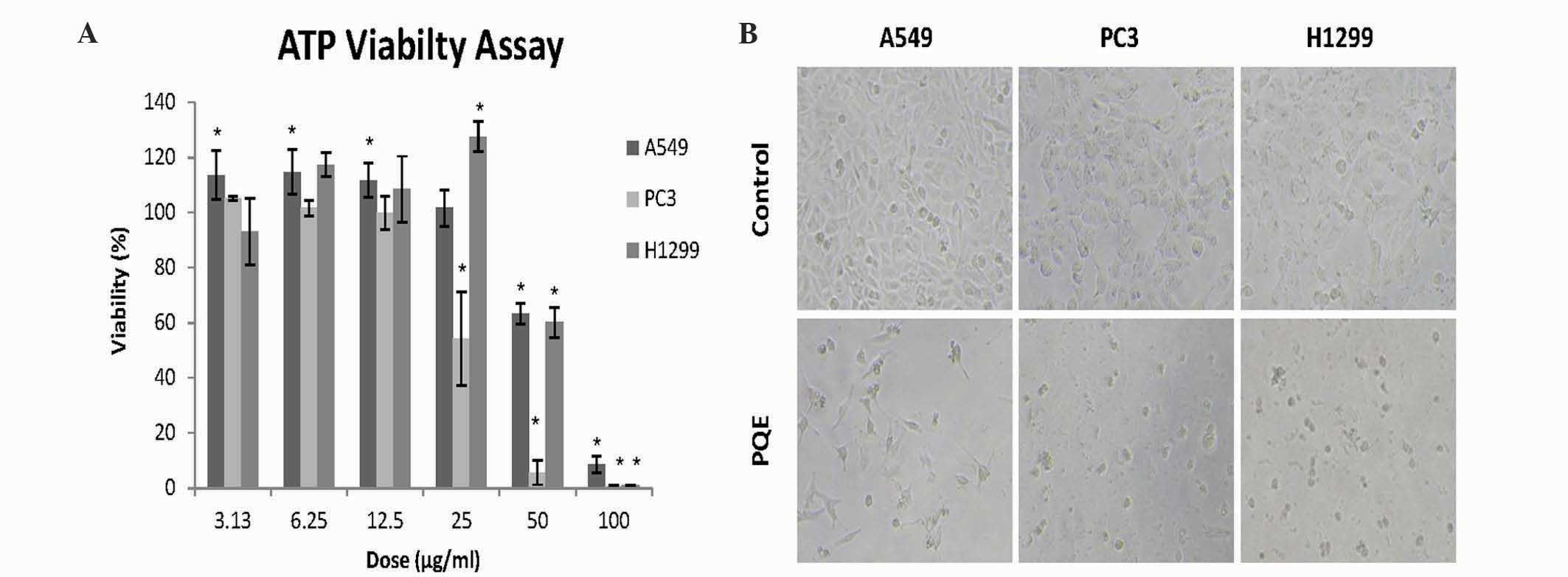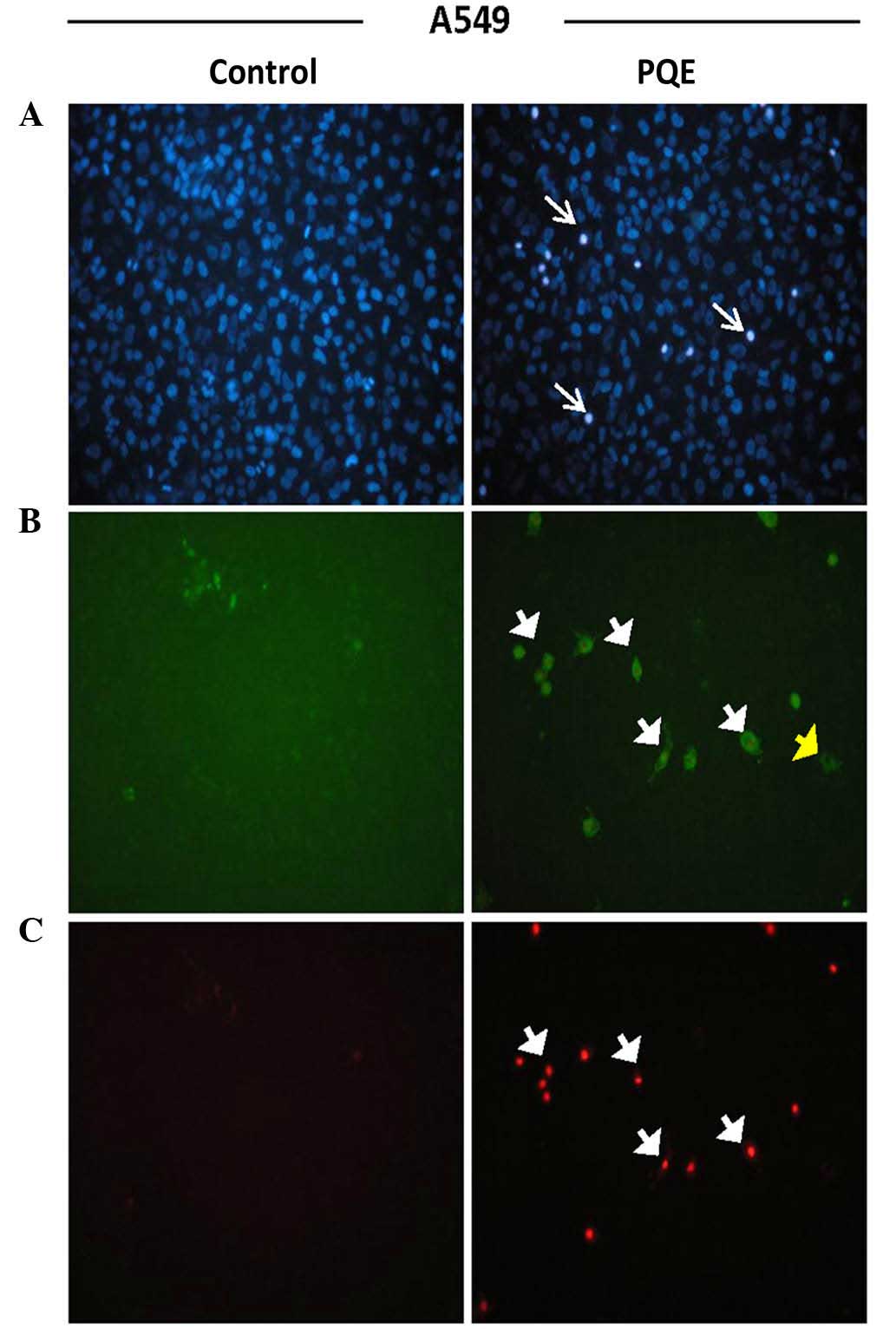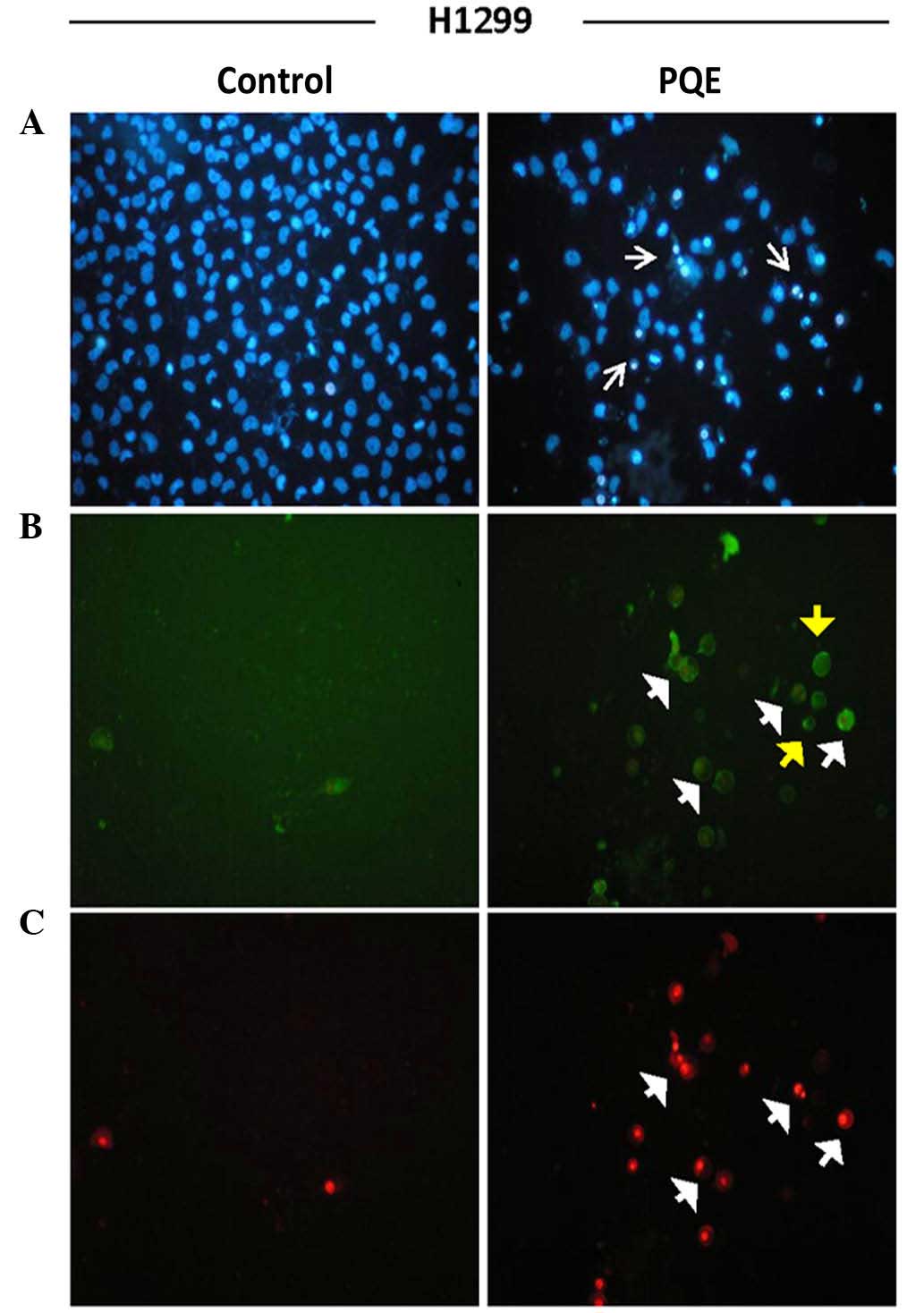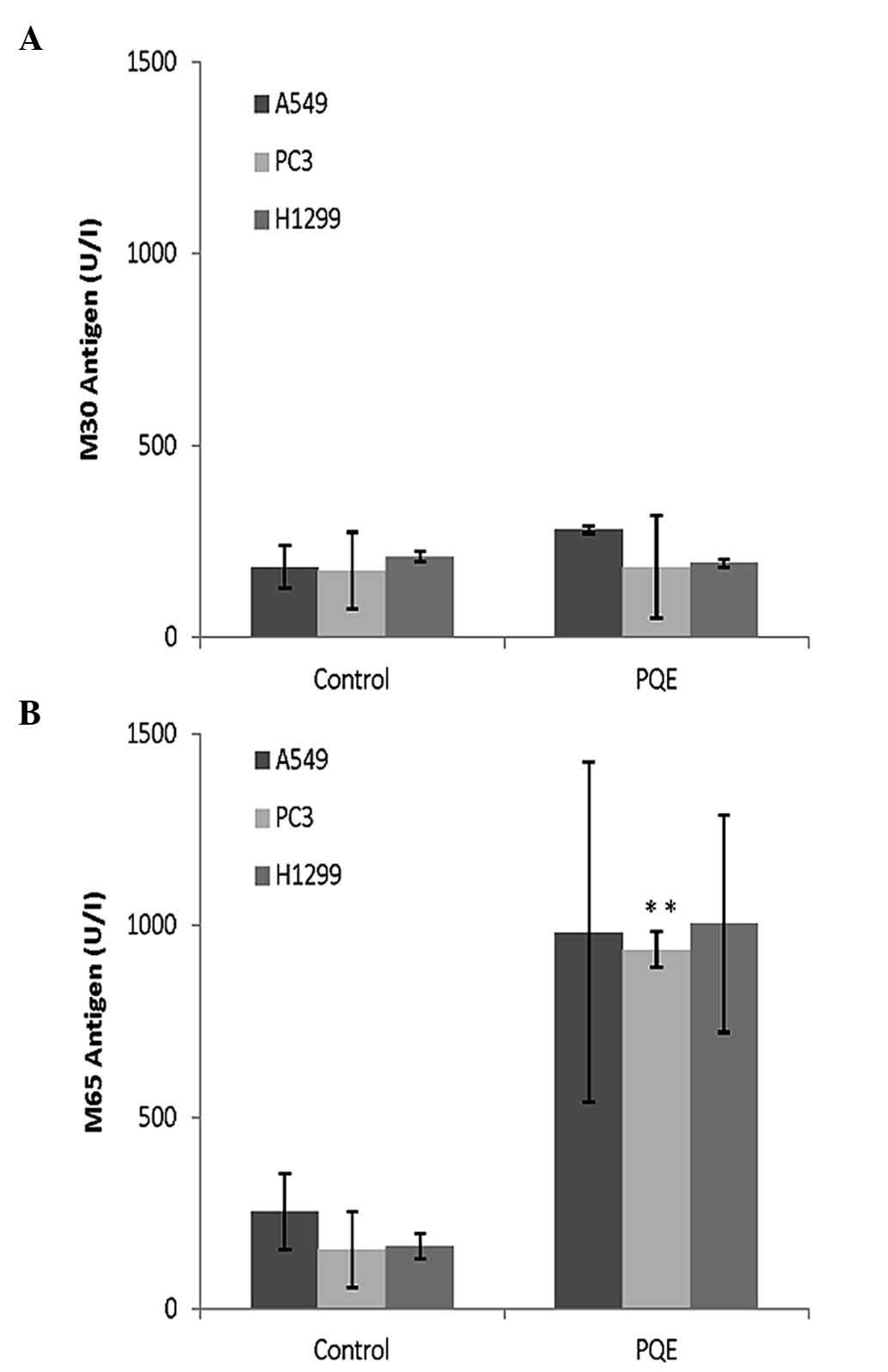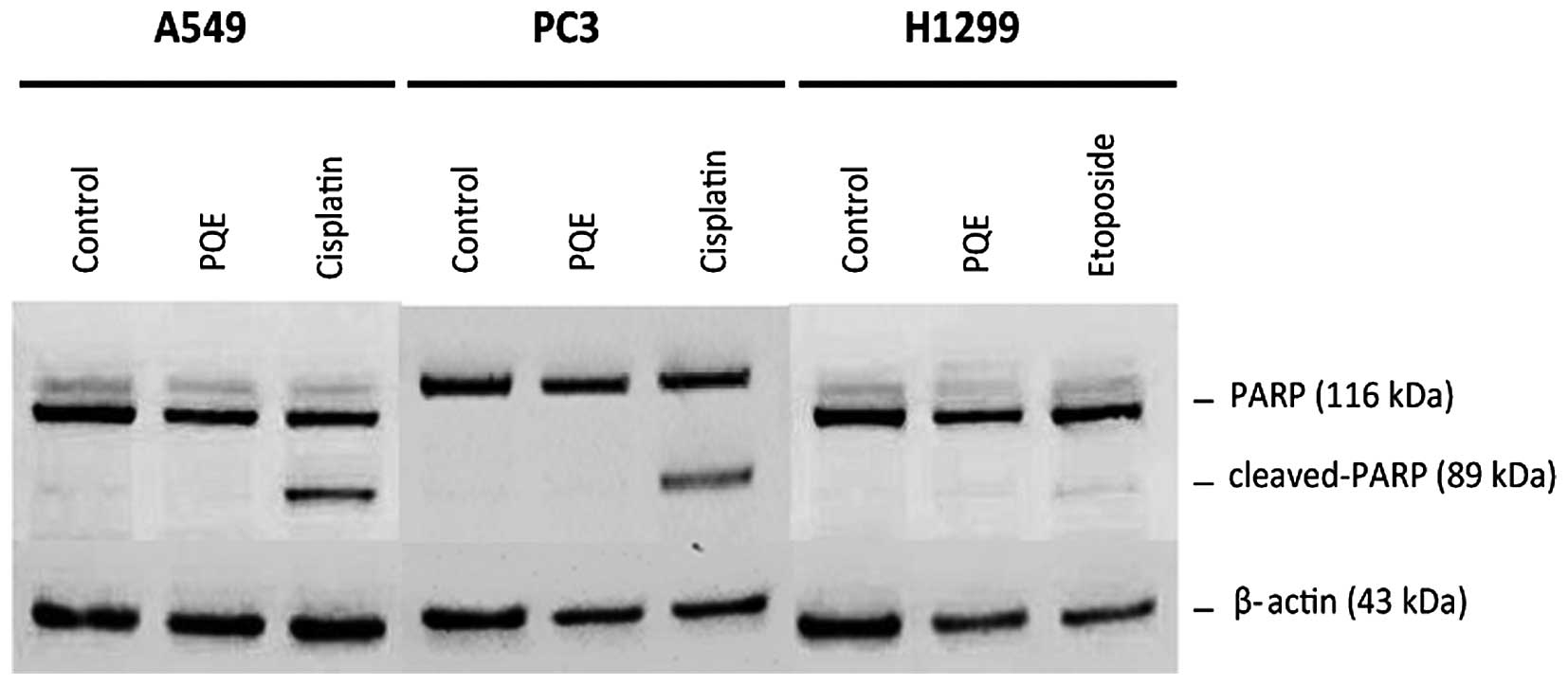|
1
|
Sanders HR and Albitar M: Somatic
mutations of signaling genes in non-small cell lung cancer. Cancer
Genet Cytogenet. 203:7–15. 2010. View Article : Google Scholar : PubMed/NCBI
|
|
2
|
Jemal A, Siegel R, Xu J and Ward E: Cancer
statistics, 2010. CA Cancer J Clin. 60:277–300. 2010. View Article : Google Scholar : PubMed/NCBI
|
|
3
|
Halberstein RA: Medicinal plants:
Historical and cross-cultural usage patterns. Ann Epidemiol.
15:686–699. 2005. View Article : Google Scholar : PubMed/NCBI
|
|
4
|
Ayo RG: Phytochemical constituents and
bioactivities of the extracts of Cassia nigricans Vahl. J
Med Plant Res. 14:1339–1348. 2010.
|
|
5
|
Cragg GM and Newman DJ: Plants as a source
of anti-cancer agents. J Ethnopharmacol. 100:72–79. 2005.
View Article : Google Scholar : PubMed/NCBI
|
|
6
|
Latté KP and Kolodziej H: Antioxidant
properties of phenolic compounds from Pelargonium reniforme. J
Agric Food Chem. 52:4899–4902. 2004. View Article : Google Scholar : PubMed/NCBI
|
|
7
|
Kolodziej H: Pelargonium reniforme
and Pelargonium sidoides: Their botany, chemistry and
medicinal use. Geranium and Pelargonium, Series: Medicinal
and Aromatic Plants - Industrial Profiles. Lis-Balchin M: 27:Taylor
and Francis. (London). 262–290. 2002.
|
|
8
|
Lalli JYY, Van Zyl RL, Van Vuuren SF and
Viljoen AM: In vitro biological activities of South African
Pelargonium (Geraniaceae) species. South African Journal of
Botany. 74:153–157. 2008. View Article : Google Scholar
|
|
9
|
Saraswathi J, Venkatesh K, Baburao N,
Hilal MH and Rani AR: Phytopharmacological importance of
Pelargonium species. J Med Plant Res. 5:2587–2598. 2011.
|
|
10
|
Yanishlieva NV, Marinova E, Gordon MH and
Raneva VG: Antioxidant activity and mechanism of action of thymol
and carvacrol in two lipid systems. Food Chem. 64:59–66. 1999.
View Article : Google Scholar
|
|
11
|
Kris-Etherton PM, Hecker VK, Bonanome A,
Coval SM, Binkoski AE, Hilpert KF, Griel AE and Etherton TD:
Bioactive compounds in foods: Their role in the prevention of
cardiovascular disease and cancer. Am J Med. 113(Suppl 9B):
71S–88S. 2002. View Article : Google Scholar : PubMed/NCBI
|
|
12
|
Seidel V and Taylor PW: In vitro activity
of extracts and constituents of Pelargonium against rapidly growing
mycobacteria. Int J Antimicrob Agents. 23:613–619. 2004. View Article : Google Scholar : PubMed/NCBI
|
|
13
|
Fayed S: Antioxidant and anticancer
activities of Citrus reticulate (Petitgrain mandarin)
and Pelargonium graveolens (Geranium) essential oils.
Research Journal of Agriculture and Biological Sciences. 5:740–747.
2009.
|
|
14
|
Kolodziej H: Fascinating metabolic pools
of Pelargonium sidoides and Pelargonium reniforme, traditional and
phytomedicinal sources of the herbal medicine Umckaloabo.
Phytomedicine. 14(Suppl 6): 9–17. 2007. View Article : Google Scholar : PubMed/NCBI
|
|
15
|
Moyo M and Van Staden J: Medicinal
properties and conservation of Pelargonium sidoides DC. J
Ethnopharmacol. 152:243–255. 2014. View Article : Google Scholar : PubMed/NCBI
|
|
16
|
Mativandlela SPN, Lall N and Meyer JJM:
Antibacterial, antifungal and antitubercular activity of (the roots
of) Pelargonium reniforme (CURT) and Pelargonium
sidoides (DC) (Geraniaceae) root extracts. South African
Journal of Botany. 72:232–237. 2006. View Article : Google Scholar
|
|
17
|
Boukhris M, Bouaziz M, Feki I, Jemai H, El
Feki A and Sayadi S: Hypoglycemic and antioxidant effects of leaf
essential oil of Pelargonium graveolens L'Hér. in alloxan induced
diabetic rats. Lipids in health and disease. 11:812012. View Article : Google Scholar : PubMed/NCBI
|
|
18
|
Fang HJ, Su XL, Liu HY, Chen YH and Ni JH:
Studies on the chemical components and anti-tumour action of the
volatile oils from Pelargonium graveoleus. Yao Xue Xue Bao.
24:366–371. 1989.(In Chinese). PubMed/NCBI
|
|
19
|
Bozan B, Ozek T, Kurkcuoglu M, Kirimer N
and Can Baser KH: The analysis of essential oil and head space
volatiles of the flowers of Pelargonium endlicherianum used as an
anthelmintic in folk medicine. Planta Medica. 65:781–782. 1999.
View Article : Google Scholar : PubMed/NCBI
|
|
20
|
Tepe B, Sokmen M, Akpulat HA, Yumrutas O
and Sokmen A: Screening of antioxidative properties of the
methanolic extracts of Pelargonium endlicherianum Fenzl.,
Verbascum wiedemannianum Fisch. and Mey., Sideritis
libanotica Labill. subsp. lineraris (Bentham) Borm.,
Centaurea mucronifera DC. and Hieracium cappadocicum
Freyn from Turkish flora. Food Chemistry. 98:9–13. 2006. View Article : Google Scholar
|
|
21
|
Ozbilge H, Kaya EG, Taskin OM and Kosar M:
Antimicrobial activity of Pelargonium endlicherianum Fenzl.
(Geraniaceae) roots against some microorganisms. J Med Plant Res.
4:2647–2650. 2010.
|
|
22
|
Asnawi S, Mohd ZZ, Aziz Abdul A, Khamis AK
and Abdul Aziz B: Evaluation of the potential of Pelargonium Radula
extract in repelling Aedes Aegypti. Journal of Chemical &
Natural Resources Engineering. 2:11–19. 2008.
|
|
23
|
Lis-Balchin M, Buchbauer G, Ribisch K and
Wenger MT: Comparative antibacterial effects of novel Pelargonium
essential oils and solvent extracts. Lett Appl Microbiol.
27:135–141. 1998. View Article : Google Scholar : PubMed/NCBI
|
|
24
|
Scott G, Springfield EP and Coldrey N: A
pharmacognostical study of 26 South African plant species used as
traditional medicines. Pharmaceutical Biology. 42:186–213. 2004.
View Article : Google Scholar
|
|
25
|
Grieve M: Tansy. Modern Herbal: The
Medicinal, Culinary, Cosmetic and Economic Properties, Cultivation
and Folklore of Herbs, Grasses, Fungi, Shrubs and Trees with All
Their Modern Scientific Uses. Leyel CF: Penguin. (Middleburg).
789–790. 1984.
|
|
26
|
Bown D: The Herb Society of America New
Encyclopedia of Herbs and Their Uses. Dorling Kindersley Publishing
Inc. New York, NY: 1995.
|
|
27
|
Kaval I, Behçet L and Cakilcioglu U:
Ethnobotanical study on medicinal plants in Geçitli and its
surrounding (Hakkari-Turkey). J Ethnopharmacol. 155:171–184. 2014.
View Article : Google Scholar : PubMed/NCBI
|
|
28
|
Davis PH: Flora of Turkey and the East
Aegean Islands. 1:Edinburgh University Press. Edinburgh: 11965.
|
|
29
|
Davis PH, Mill RR and Tan K: Flora of
Turkey and the east Aegean Islands. 10(Suppl 1)Edinburgh
Universitys Press. Edinburgh: 1061988.
|
|
30
|
Andreotti PE, Cree IA, Kurbacher CM,
Hartmann DM, Linder D, Harel G, Gleiberman I, Caruso PA, Ricks SH,
Untch M, et al: Chemosensitivity testing of human tumors using a
microplate adenosine triphosphate luminescence assay: Clinical
correlation for cisplatin resistance of ovarian carcinoma. Cancer
Res. 55:5276–5282. 1995.PubMed/NCBI
|
|
31
|
Ari F, Aztopal N, Icsel C, Yilmaz VT,
Guney E, Buyukgungor O and Ulukaya E: Synthesis, structural
characterization and cell death-inducing effect of novel
palladium(II) and platinum(II) saccharinate complexes with
2-(hydroxymethyl) pyridine and 2-(2-hydroxyethyl) pyridine on
cancer cells in vitro. Bioorg Med Chem. 21:6427–6434. 2013.
View Article : Google Scholar : PubMed/NCBI
|
|
32
|
Ulukaya E, Acilan C, Ari F, Ikitimur E and
Yilmaz Y: A glance at the methods for detection of apoptosis
qualitatively and quantitatively. Turkish Journal of Biochemistry.
36:261–269. 2011.
|
|
33
|
Hammill AK, Uhr JW and Scheuermann RH:
Annexin V staining due to loss of membrane asymmetry can be
reversible and precede commitment to apoptotic death. Exp Cell Res.
251:16–21. 1999. View Article : Google Scholar : PubMed/NCBI
|
|
34
|
Zhang G, Gurtu V, Kain SR and Yan G: Early
detection of apoptosis using a fluorescent conjugate of annexin V.
Biotechniques. 23:525–531. 1997.PubMed/NCBI
|
|
35
|
Linder S, Olofsson MH, Herrmann R and
Ulukaya E: Utilization of cytokeratin-based biomarkers for
pharmacodynamic studies. Expert Rev Mol Diagn. 10:353–359. 2010.
View Article : Google Scholar : PubMed/NCBI
|
|
36
|
Chiu CC, Lin CH and Fang K: Etoposide
(VP-16) sensitizes p53-deficient human non-small cell lung cancer
cells to caspase-7-mediated apoptosis. Apoptosis. 10:643–650. 2005.
View Article : Google Scholar : PubMed/NCBI
|
|
37
|
Dasgupta P, Kinkade R, Joshi B, DeCook C,
Haura E and Chellappan S: Nicotine inhibits apoptosis induced by
chemotherapeutic drugs by up-regulating XIAP and survivin. Proc
Natl Acad Sci USA. 103:6332–6337. 2006. View Article : Google Scholar : PubMed/NCBI
|
|
38
|
Zhang X, Ling MT, Wong YC and Wang X:
Evidence of a novel antiapoptotic factor: Role of inhibitor of
differentiation or DNA binding (Id-1) in anticancer drug-induced
apoptosis. Cancer Sci. 98:308–314. 2007. View Article : Google Scholar : PubMed/NCBI
|
|
39
|
NIST: Automated Mass Spectral
Deconvolution and Identification System 2005 version. National
Institute of Standards and Technology. US Department of Commerce.
(USA). 2005.
|
|
40
|
Jemal A, Bray F, Center MM, Ferlay J, Ward
E and Forman D: Global Cancer Statistics. CA Cancer J Clin.
61:69–90. 2011. View Article : Google Scholar : PubMed/NCBI
|
|
41
|
de Moura MD, Silva JDS, de Oliveira RAG,
Diniz MDFFM and Barbosa-Filho JM: Natural products reported as
potential inhibitors of uterine cervical neoplasia. Acta
Farmacéutica Bonaerense. 21:67–74. 2002.
|
|
42
|
Lis-Balchin M: Geranium oil. International
Journal of Aromatherapy. 7:18–20. 1996. View Article : Google Scholar
|
|
43
|
Haag JD, Lindstrom MJ and Gould MN:
Limonene-induced regression of mammary carcinomas. Cancer Res.
52:4021–4026. 1992.PubMed/NCBI
|
|
44
|
Zhuang SR, Chen SL, Tsai JH, Huang CC, Wu
TC, Liu WS, Tseng HC, Lee HS, Huang MC, Shane GT, et al: Effect of
citronellol and the Chinese medical herb complex on cellular
immunity of cancer patients receiving chemotherapy/radiotherapy.
Phytother Res. 23:785–790. 2009. View Article : Google Scholar : PubMed/NCBI
|
|
45
|
Cevatemre B, Ulukaya E, Sarimahmut M, Oral
AY and Frame FM: The M30 assay does not detect apoptosis in
epithelial-derived cancer cells expressing low levels of
cytokeratin 18. Tumor Biol. 36:6857–6865. 2015. View Article : Google Scholar
|
|
46
|
Ulukaya E, Acilan C and Yilmaz Y:
Apoptosis: Why and how does it occur in biology? Cell Biochem
Funct. 29:468–480. 2011. View Article : Google Scholar : PubMed/NCBI
|
|
47
|
Nicholson DW, Ali A, Thornberry NA,
Vaillancourt JP, Ding CK, Gallant M, Gareau Y, Griffin PR, Labelle
M, Lazebnik Y, et al: Identification and inhibition of the
ICE/CED-3 protease necessary for mammalian apoptosis. Nature.
376:37–43. 1995. View Article : Google Scholar : PubMed/NCBI
|
|
48
|
Alnemri ES: Mammalian cell death
proteases: A family of highly conserved aspartate specific cysteine
proteases. J Cell Biochem. 64:33–42. 1997. View Article : Google Scholar : PubMed/NCBI
|
|
49
|
Galluzzi L, Vitale I, Abrams JM, Alnemri
ES, Baehrecke EH, Blagosklonny MV, Dawson TM, Dawson VL, El-Deiry
WS, Fulda S, et al: Molecular definitions of cell death
subroutines: Recommendations of the Nomenclature Committee on Cell
Death 2012. Cell Death Differ. 19:107–120. 2012. View Article : Google Scholar : PubMed/NCBI
|
|
50
|
Gown AM and Willingham MC: Improved
detection of apoptotic cells in archival paraffin sections:
Immunohistochemistry using antibodies to cleaved caspase 3. J
Histochem Cytochem. 50:449–454. 2002. View Article : Google Scholar : PubMed/NCBI
|















